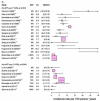Heterosexual HIV-1 infectiousness and antiretroviral use: systematic review of prospective studies of discordant couples
- PMID: 23222513
- PMCID: PMC4312663
- DOI: 10.1097/EDE.0b013e318276cad7
Heterosexual HIV-1 infectiousness and antiretroviral use: systematic review of prospective studies of discordant couples
Abstract
Background: Recent studies have estimated the reduction in HIV-1 infectiousness with antiretroviral therapy (ART), but high-quality studies such as randomized controlled trials, accompanied by rigorous adherence counseling, are likely to overestimate the effectiveness of treatment-as-prevention in real-life settings.
Methods: We attempted to summarize the effect of ART on HIV transmission by undertaking a systematic review and meta-analysis of HIV-1 infectiousness per heterosexual partnership (incidence rate and cumulative incidence over study follow-up) estimated from prospective studies of discordant couples. We used random-effects Poisson regression models to obtain summary estimates. When possible, the analyses were further stratified by direction of transmission (man-to-woman or woman-to-man) and economic setting (high- or low-income countries). Potential causes of heterogeneity of estimates were explored through subgroup analyses.
Results: Fifty publications were included. Nine allowed comparison between ART and non-ART users within studies (ART-stratified studies), in which summary incidence rates were 3.6/100 person-years (95% confidence interval = 2.0-6.5) and 0.2/100 person-years (0.07-0.7) for non-ART- and ART-using couples, respectively (P < 0.001), constituting a 91% (79-96%) reduction in per-partner HIV-1 incidence rate with ART use. The 41 studies that did not stratify by ART use provided estimates with high levels of heterogeneity (I statistic) and few reported levels of ART use, making interpretation difficult. Nevertheless, estimates tended to be lower with ART use. Infectiousness tended to be higher for low-income than high-income settings, but there was no clear pattern by direction of transmission (man-to-woman and woman-to-man).
Conclusions: ART substantially reduces HIV-1 infectiousness within discordant couples, based on observational studies, and could play a major part in HIV-1 prevention efforts. However, the non-zero risk from partners receiving ART demonstrates that appropriate counseling and other risk-reduction strategies for discordant couples are still required. Additional estimates of ART effectiveness by adherence level from real-life settings will be important, especially for persons starting treatment early without symptoms.
Figures








References
-
- UNAIDS/WHO [Accessed April 21st 2012];Global HIV/AIDS response. Epidemic update and health sector progress towards Universal Access. Progress report 2011. 2011 Available at: http://www.who.int/hiv/pub/progress_report2011/summary_en.pdf.
-
- Granich RM, Gilks CF, Dye C, De Cock KM, Williams BG. Universal voluntary HIV testing with immediate antiretroviral therapy as a strategy for elimination of HIV transmission: a mathematical model. Lancet. 2009 Jan 3;373(9657):48–57. - PubMed
-
- Shiboski SC, Padian NS. Epidemiologic evidence for time variation in HIV infectivity. J Acquir Immune Defic Syndr Hum Retrovirol. 1998 Dec 15;19(5):527–35. - PubMed
-
- Shiboski SC, Jewell NP. Statistical analysis of the time dependence of HIV infectivity based on partner study data. J Am Stat Assoc. 1992;87:360–72.
Publication types
MeSH terms
Substances
Grants and funding
LinkOut - more resources
Full Text Sources
Other Literature Sources
Medical

